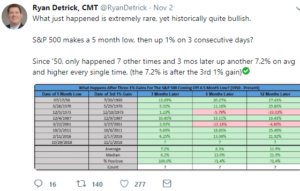With the 2.5% rally this week in the SP 500, the SP 500 “earnings yield” ended Friday, November 2nd, 2018 at 6.36% vs last week’s 6.52%.
The last time we saw a lengthy string of SP 500 earnings yield prints above 6% was late 2015, early 2016.
Pretty much the whole first quarter of 2016, when crude oil bottomed at $28, saw the 12 weeks above 6% during that stressful period.
SP 500 Earnings By the Numbers: (Source: Refinitiv IBES)
- Fwd 4qtr est: $173.24 vs last week’s $173.24
- PE ratio: 15.7x
- PEG ratio: 0.72x
- SP 500 earnings yield: 6.36%
- Year-over-year growth of fwd est: +21.86%
The “forward 4-quarter” estimate as well as the quarterly bottom-up estimates for Q3 and Q4 ’18 remained exactly the same this week (as last week) so a note was sent to the Refinitiv IBES team asking if there was an error with the reporting this week.
With 140 SP 500 companies reporting earnings last week, I find the fact that the estimates are EXACTLY the same for two different data sets puzzling. There was no response from Refinitiv IBES Friday night, so perhaps we’ll get an explanation Monday, November 5th, 2018.
Summary / conclusion: Ryan Detrick, LPL’s excellent Strategist, Mike Santoli, the frequent CNBC commentator on all things market-related and a number of other “statistical” gurus commented that the three straight 1% up days in the SP 500 this week typically occur around market bottoms, as Ryan noted here, cut-and-pasted from Twitter (@ryandetrick):

The SP 500 is trying to figure what 2019 will look like, and thus far both Factset and Refinitiv IBES have a 10% SP earnings growth penciled in, along with a 5% revenue growth expectation for the next calendar year.
Here is the tricky part – 2018 was a year of “P.E compression”. SP 500 earnings growth was 23% and the SP 500 is up just 2.5% – 3% so far in 2018. (This blog wrote about P.E contraction in the last 12 months here, here, and here.)
The point being that the SP 500 is likely to see much slower earnings and revenue growth within the SP 500 next year, and yet if we get a year of P.E expansion, the key benchmark could have an average year returning 7% – 10%, or even more.
My own tilt is that interest rates and how aggressive the Fed / FOMC gets on the short end will have much to do with the “P.E expansion / contraction” debate for 2019.
Picked up on a Jeff Miller tweet (@dashofinsight), Josh Brown (@reformedbroker) tweeted about “P.E contraction” on October 30, 2018.
It may just be “1994″ all over again (an Orwellian reference for sure), but the fed funds rate hikes are so similar.
Thanks for reading.
